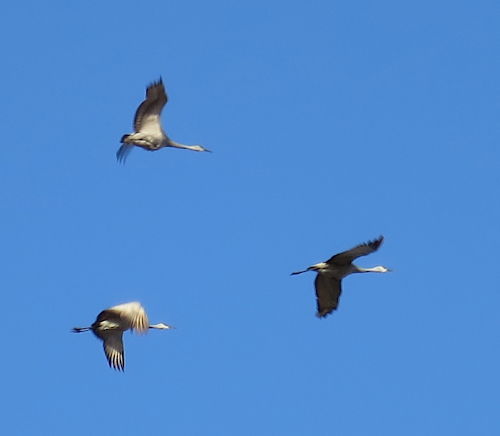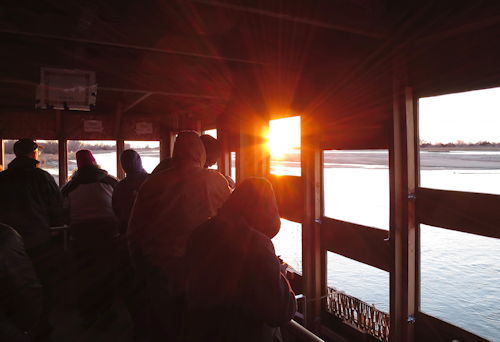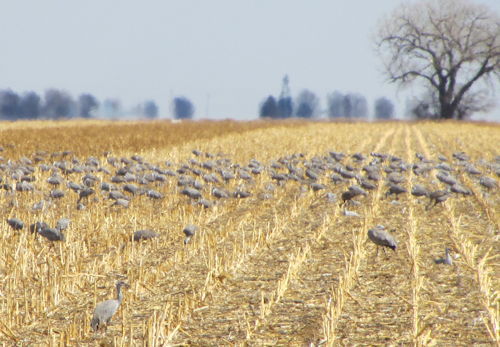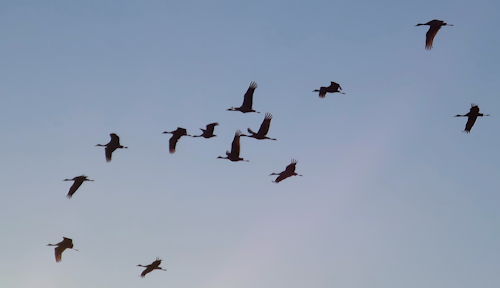Nebraska's top tourist attraction isn't its Softball Hall of Fame. Nor the hundreds of dinosaurs whose sudden deaths are still being studied at Ashfall Fossil Beds State Historical Park, aka the Prairie Pompeii. Nebraska's top tourist attraction isn't its annual Peep Show, where the wags of York (home of the York News Times -- get it?) make hilarious artworks out of marshmallow Peeps. Gigantic steaks? Plainview's toy-clown museum? World's largest Kool-Aid stand? No, no and no. Nebraska's top tourist attraction, not just marginally topmost but winning by a cornfield-wide margin, is its 500,000 gangly-necked, golden-eyed, scarlet-scalped sandhill cranes.
But can we legitimately say its sandhill cranes? These yard-tall birds with six-foot wingspans are, like most of us, merely visiting. Midway through their annual migration, they descend every March upon an 80-mile swatch of the Platte River, where they spend one month sleeping and feasting before taking flight for their Siberian breeding grounds. Evidence suggests that they and their ancestors have been doing this for over 6 million years.
"For the month they're here, this is their home," our guide told us last week at the Audubon-affiliated Rowe Sanctuary in Kearney, whose rustic, many-windowed wooden blinds -- like the ones from which hunters shoot ducks -- are among the Platte's prime crane-viewing stations. As we prepared in twenty-degree predawn darkness to file toward our blind, Ellis warned us to maintain deathly silence so as not to spook the birds, which need to conserve as much energy as possible given their strenuous northward sojourn but which upset easily: Their large size, large numbers, poor eyesight and the fact that they sleep standing up in icy shallow water make them vulnerable: a fact not lost on hunters in nearby states; in Nebraska the cranes are protected.
"They're aware that they get shot at in Kansas," our guide said. "This is their rendezvous. The river is their moat."
The point of arriving before dawn is to watch them wake, chortling as they stir like a vast gray flannel blanket up and down the shallows, then rising two by two then ten by ten then thirty by thirty in rippling skyborne waves to search surrounding fields for fallen corn, young plants, and cow dung, from which the cranes pluck bugs on which they feast.
Although they sleep in a river, sandhill cranes eat no fish. Sometimes biology just makes no sense.
And for that month which ends next week they ascend daily at sundown from the fields, returning to the shallow-as-a-cat-scratch Platte. Visitors line the blinds at Rowe and at the Crane Trust Nature & Visitor Center in nearby Wood River to watch this sundown spectacle as well, cameras poised at little windows high and low that, from the cranes' vantage point, make these wooden walls resemble advent calendars. Down through the denim sky they come, two by two, ten by ten, thirty by thirty, thousand by thousand, tracing lazy script across clear prairie air, as sinuous as flying violins.
Photographs by Kristan Lawson. All images used by permission.




